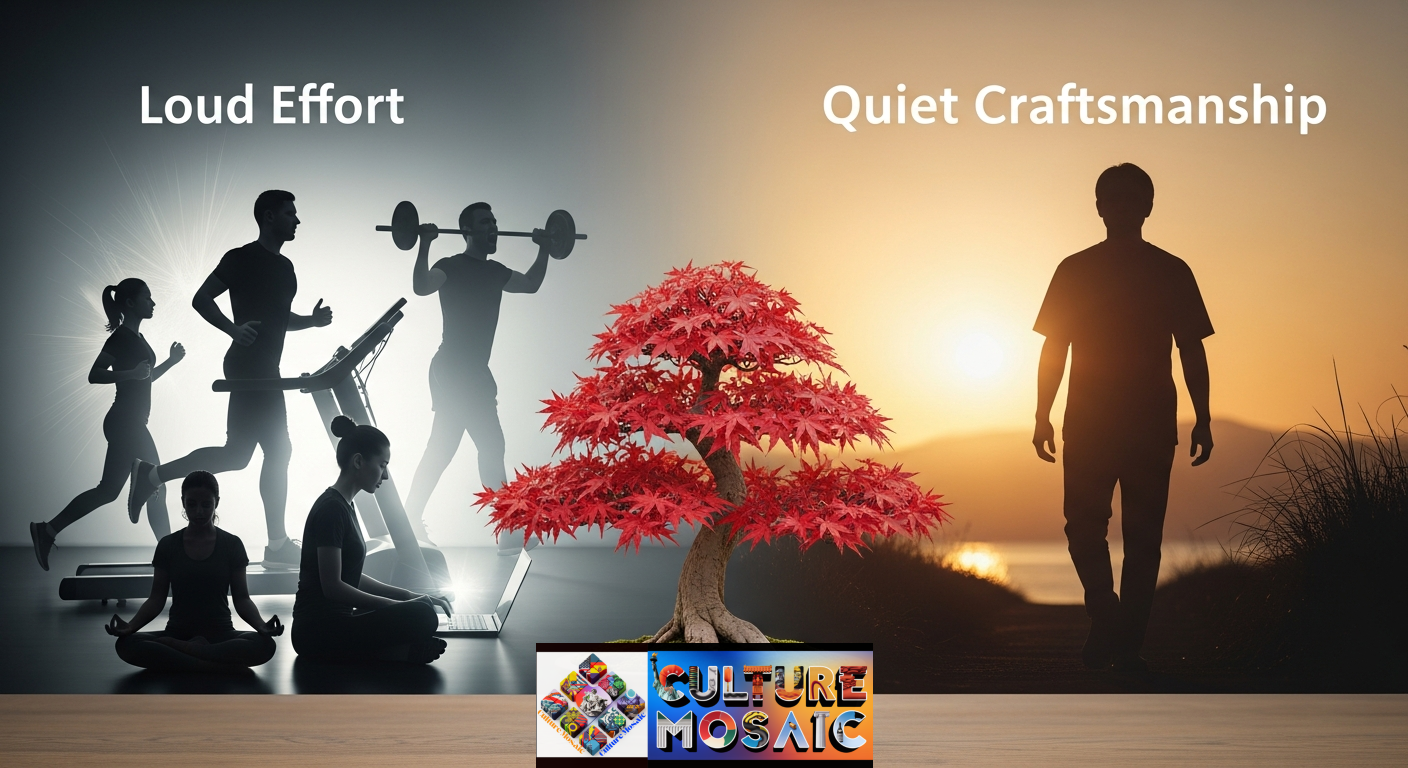Introduction: The New Definition of Success
Something shifted in American culture recently. The Instagram-ready morning routines, the 5 AM grind sessions, the constant productivity hacks—they’re losing their appeal. More US adults are questioning whether all that visible effort actually leads to genuine well-being.
Enter regenerative well-being practices for US adults: a completely different approach to personal growth. This isn’t about doing more. It’s about doing what matters, with intention, away from the performance stage of social media. Think of it as the quiet luxury movement, but for your inner life.
The numbers tell the story. Burnout rates among American workers hit record highs in recent years, with over 70% reporting exhaustion. Meanwhile, searches for terms like “slow living” and “intentional living” have surged. People are tired of performing their wellness. They want the real thing.
Understanding Regenerative Well-Being Practices for US Adults

Regenerative well-being practices for US adults represent a fundamental shift in how we approach self-improvement. Instead of extracting more from yourself—more productivity, more achievement, more visible success—regenerative practices focus on restoration and sustainable growth.
Here’s what makes these practices different:
They prioritize internal experience over external validation. Your meditation practice doesn’t need to be photographed. Your therapy sessions don’t require a LinkedIn post. The growth happens in private, building a foundation that actually holds.
They recognize that real change takes time. There’s no 21-day transformation or weekend breakthrough. Regenerative well-being practices for US adults acknowledge that meaningful development unfolds slowly, like a high-quality garment that lasts decades rather than one season.
They reject the depletion model of success. Hustle culture operated on the assumption that you could always push harder, sleep less, and optimize more. Regenerative practices start from a different premise: sustainable well-being comes from working with your natural rhythms, not against them.
The Shift from Loud Effort to Quiet Craftsmanship

American culture has long celebrated visible effort. The all-nighters. The packed schedules. The exhaustion was worn as a badge of honor. But regenerative well-being practices for US adults are rewriting this narrative.
Quality Over Quantity in Daily Practice
Consider two people working on their mental health. The first person follows a complex morning routine: journaling, meditation, affirmations, cold showers, green smoothies, and a workout—all before 7 AM. They post about it regularly. The second person takes a single 15-minute walk each morning, paying attention to their breath and surroundings. No phone. No agenda. Just presence.
Which practice is more likely to still exist six months from now?
Regenerative well-being practices for US adults recognize that one deep, sustainable habit beats five shallow ones. It’s the difference between buying a well-made coat you’ll wear for years versus filling your closet with fast fashion that falls apart in months.
This approach requires a different kind of discipline. Not the white-knuckle forcing of unwanted behaviors, but the patient cultivation of practices that genuinely fit your life. It means asking: Does this actually nourish me, or am I doing it because it looks good?
Intrinsic Motivation as the Foundation
The loudest self-improvement has always been powered by external motivation. Impressing others. Proving something. Competing with the curated highlight reels of social media.
Regenerative well-being practices for US adults flip this completely. They’re built on intrinsic motivation—the internal pull toward growth because it makes your life genuinely better.
This shift shows up in small ways. You might start reading again, not to hit some arbitrary book goal, but because you miss the feeling of being absorbed in a story. You might return to therapy, not because everyone else is, but because you’re genuinely curious about your patterns.
The difference is subtle but profound. External motivation creates pressure and eventual resentment. Intrinsic motivation creates sustainable momentum.
The Power of Discretion in Personal Growth
There’s something counterintuitive happening in regenerative well-being practices for US adults: the most meaningful changes often happen in private.
Your most important insights might come during a quiet afternoon walk, not announced on social media. Your biggest breakthroughs might happen in therapy sessions no one else knows about. The relationship patterns you’re working to change might shift gradually, invisibly, over months.
This discretion isn’t about secrecy. It’s about protecting your process from the distorting effect of public performance. When you’re not performing your growth for an audience, you can be honest about what’s actually working and what isn’t.
Curating the Inner Life: Investment in Timeless Well-being

If quiet luxury is about choosing timeless quality over trendy quantity, then regenerative well-being practices for US adults apply this same principle to your mental and emotional landscape.
Mental Minimalism and Digital Boundaries
Your mental space is limited. Every notification, every scroll, every context switch takes up room. Regenerative well-being practices for US adults start with protecting this space.
This looks like practical steps, not abstract ideals. Turning off non-essential notifications. Setting specific times to check email rather than responding to every ping. Designating phone-free hours where you can think without interruption.
But it goes deeper than digital hygiene. Mental minimalism means being selective about what you allow into your awareness. Not every trending controversy requires your opinion. Not every opportunity needs your yes. Not every relationship deserves your emotional energy.
US adults practicing regenerative well-being report that this selectivity doesn’t feel restrictive. It feels like finally having room to breathe.
Emotional Resilience as Long-Term Investment
Fast fashion comes and goes. Quality pieces last. The same principle applies to emotional well-being.
Regenerative well-being practices for US adults treat emotional intelligence as an investment, not a quick fix. This means developing skills that serve you across decades: understanding your attachment patterns, building genuine self-compassion, and learning to regulate your nervous system.
These aren’t sexy skills. No one’s going to congratulate you for recognizing when you’re in a trauma response and choosing to pause instead of react. But this kind of emotional craftsmanship changes everything about how you move through soft life.
Think of it as buying the emotional equivalent of a well-made cashmere sweater. It costs more upfront—more time in therapy, more discomfort facing patterns, more patience with slow progress. But it lasts. And it gets better with time.
The Luxury of Time and Stillness
In a culture that commodifies every moment, regenerative well-being practices for US adults reclaim time as something other than a productivity resource.
This means scheduling deliberate rest, not as a means to future productivity, but as an end in itself. Taking a Saturday afternoon to read without checking if you’re absorbing information efficiently. Spending an evening cooking a slow meal without photographing it. Sitting on your porch doing absolutely nothing.
US adults who adopt these practices report something unexpected: boredom transforms. The restless, anxious need to fill every moment starts to fade. What emerges is something closer to contentment—a quiet satisfaction with simply existing.
This isn’t laziness or opting out. It’s recognizing that constant stimulation isn’t rest, and productivity isn’t meaning.
The Subtle Signal: Self-Improvement that Speaks for Itself

The ultimate marker of regenerative well-being practices for US adults isn’t what you announce. It’s what people notice without you saying anything.
Effortless Elegance in Your Presence
You’ve probably met someone with this quality. They’re calm in chaos. They listen without immediately offering solutions or steering the conversation back to themselves. They seem comfortable with silence. They’re present.
This isn’t a performance. It’s the natural outcome of doing the quiet work. When you’ve spent time understanding your reactivity, you stop being so reactive. When you’ve practiced genuine self-compassion, you stop needing to prove yourself constantly. When you’ve cultivated inner stability, you don’t get knocked sideways by every minor disturbance.
Regenerative well-being practices for US adults create this quality not through affectation but through genuine development. It’s the difference between acting confident and actually being secure.
The In-the-Know Community
Something interesting happens when you commit to regenerative well-being practices for US adults. You start recognizing others on the same path.
It’s not about credentials or visible markers. It’s a subtle recognition. You notice the person who listens more than they talk. The colleague who sets boundaries without apology or explanation. The friend who can be genuinely happy for others’ success without diminishing their own.
These connections tend to be deeper than surface-level networking. They’re based on shared values: quality over quantity, substance over performance, genuine growth over maintaining appearances.
This community doesn’t require membership or announcement. It forms naturally among people who’ve chosen depth.
Longevity and Sustainable Change
The biggest promise of regenerative well-being practices for US adults is also the least flashy: they actually last.
Unlike hustle culture’s boom-and-bust cycles—intense effort followed by burnout and retreat—regenerative practices create sustainable rhythms. You can maintain them not just for months but for years. They become part of who you are rather than something you’re forcing yourself to do.
This sustainability comes from alignment. These practices work with your nature, not against it. They honor your limits instead of constantly pushing past them. They create genuine improvements in how you feel, not just how you look to others.
The result is a change that compounds quietly over time. Small, consistent practices accumulate into significant transformation. But this transformation doesn’t announce itself. It simply becomes your new baseline.
Implementing Regenerative Well-Being Practices for US Adults
Understanding the concept is one thing. Actually shifting your approach is another. Here’s how to begin integrating regenerative well-being practices for US adults into your life.
Start with Honest Assessment
Before adding anything new, look at what you’re currently doing. Which of your self-improvement efforts genuinely make you feel better? What are you doing for external validation? Which has become another source of stress?
Be ruthlessly honest. That elaborate morning routine might look good on paper, but if you dread it every day, it’s not serving you.
Choose One Practice, Go Deep
Regenerative well-being practices for US adults prioritize depth over breadth. Instead of adopting five new habits, choose one that genuinely resonates and commit to it fully.
This might be a daily walk. A regular therapy session. A weekly evening with your phone in another room. Whatever you choose, give it at least three months before evaluating. Real integration takes time.
Remove Before Adding
Often, the most regenerative thing you can do is stop doing something that depletes you. Stop checking work email after hours. Stop following social media accounts that trigger comparison. Stop saying yes to commitments that drain you.
US adults practicing regenerative well-being often find that subtraction matters more than addition.
Protect Your Process from Performance
Keep some things private. Not everything needs to be shared, tracked, or optimized. Allow yourself the space to experiment, fail, and adjust without an audience.
This privacy isn’t about secrecy. It’s about creating space for genuine development without the distorting pressure of public performance.
Measure by Internal Experience
Regenerative well-being practices for US adults require different metrics than traditional self-improvement. Instead of tracking streaks or quantifiable outputs, pay attention to internal shifts.
Do you feel more grounded? Are you less reactive? Do you have more capacity for presence? Are you sleeping better? These subjective experiences matter more than any external marker.
Common Obstacles and How to Navigate Them
Adopting regenerative well-being practices for US adults means swimming against cultural currents. Here are the most common challenges and how to work with them.
The Productivity Guilt
US culture equates rest with laziness. When you start prioritizing regenerative practices, you’ll likely feel guilty about not doing more.
This guilt is cultural conditioning, not truth. Recognize it as such. Remind yourself that sustainable well-being enables long-term contribution better than short-term intensity followed by burnout.
The Invisibility Problem
No one’s going to applaud your quiet growth. There’s no like button for emotional regulation. No congratulations for choosing rest over productivity.
This invisibility is actually the point. Regenerative well-being practices for US adults teach you to find satisfaction in internal experience rather than external validation. The discomfort you feel reveals how dependent you’ve become on others’ recognition.
The Slow Progress
Regenerative practices don’t offer quick transformations. This can feel frustrating in a culture obsessed with rapid results.
Shift your timeframe. Think in seasons and years, not days and weeks. Trust that small, consistent practices compound over time, even when you can’t see immediate results.
The Peer Pressure
Your commitment to regenerative well-being practices for US adults might confuse or threaten others. People might interpret your boundaries as judgment of their choices. Your refusal to participate in performative productivity might make them uncomfortable.
Stay steady. Your practices aren’t a referendum on anyone else’s choices. You can let others live differently without abandoning what works for you.
The Cultural Context: Why Now?
Regenerative well-being practices for US adults aren’t emerging in a vacuum. Several cultural factors are driving this shift.
Burnout as the Default
Exhaustion has become so normalized in American culture that well-rested people seem like outliers. The pandemic intensified this, blurring boundaries between work and home, adding caregiving responsibilities, and eliminating many traditional sources of restoration.
US adults are recognizing that the system itself is unsustainable. Regenerative practices represent not just personal preference but necessary correction.
The Authenticity Demand
Younger generations are particularly skeptical of performance and image management. They can spot inauthenticity instantly. This creates pressure for genuine substance rather than polished surfaces.
Regenerative well-being practices for US adults align with this cultural shift toward authenticity. They’re about being real rather than looking good.
Economic Realities
The traditional markers of success—homeownership, financial security, upward mobility—feel increasingly out of reach for many US adults. When external achievements seem impossible, regardless of effort, people naturally turn inward.
Regenerative practices offer a form of wealth that’s accessible regardless of economic circumstances: internal peace, emotional resilience, and genuine relationships.
Digital Exhaustion
Americans are tired of screens. The initial novelty of constant connectivity has worn off, revealing its costs: fragmented attention, comparison anxiety, and information overload.
Regenerative well-being practices for US adults often involve deliberate disconnection, reclaiming the mental space that digital life colonized.
The Professional Application
Regenerative well-being practices for US adults aren’t just for personal life. They’re transforming how people approach work.
Redefining Professional Success
More US adults are questioning whether climbing the corporate ladder is worth the cost. They’re choosing positions with boundaries over prestigious titles that demand 60-hour weeks. They’re prioritizing flexibility over salary increases.
This isn’t laziness. It’s recognizing that professional success means nothing if you’re too depleted to enjoy life.
Sustainable Performance
Companies are starting to notice that regenerative approaches actually improve performance. Employees who practice genuine self-care are more creative, more collaborative, and more resilient than those in constant hustle mode.
Smart organizations are building regenerative principles into their cultures: encouraging actual disconnection during time off, respecting boundaries, and measuring outcomes rather than hours.
Career Longevity
Hustle culture burns people out by their thirties. Regenerative well-being practices for US adults support career longevity. When you’re not constantly depleting yourself, you can sustain high-quality work for decades.
This matters in an economy where people need to work longer. Regenerative practices aren’t just nice to have. They’re necessary for long-term professional viability.
Conclusion: The Quiet Revolution
Regenerative well-being practices for US adults represent a profound cultural shift. From extraction to restoration. From performance to presence. From proving to being.
This isn’t about opting out or giving up. It’s about recognizing that the old model doesn’t work. Hustle culture promised that relentless effort would lead to success and happiness. For most people, it delivered exhaustion and emptiness instead.
The regenerative approach offers something different: sustainable well-being built on quality practices, intrinsic motivation, and genuine self-knowledge. It’s quieter. It’s slower. It’s less visible. And it actually works.
The shift won’t happen overnight. You’re unwinding decades of cultural conditioning. But each small choice—to rest instead of push, to prioritize internal experience over external validation, to protect your energy instead of giving it away—moves you toward a different way of being.
The luxury of regenerative well-being practices for US adults isn’t about expensive retreats or exclusive programs. It’s about reclaiming your life from the constant demand to do more, be more, and achieve more. It’s about discovering that enough is already here.
Your most meaningful growth will probably happen in private. Your most important changes might go unnoticed by others. And that’s exactly the point.
Frequently Asked Questions
What are regenerative well-being practices for US adults?
Regenerative well-being practices for US adults are approaches to personal growth and self-care that prioritize restoration and sustainability over intensity and performance. Unlike hustle culture’s extraction model, these practices work with your natural rhythms to create lasting change without burnout. They focus on quality over quantity, internal experience over external validation, and gradual transformation over quick fixes.
How are regenerative well-being practices different from traditional self-improvement?
Traditional self-improvement often emphasizes visible achievement, rapid transformation, and constant optimization. Regenerative well-being practices for US adults instead focus on sustainable rhythms, intrinsic motivation, and personal growth. The difference is between forcing yourself to maintain exhausting routines for external validation versus developing practices that genuinely nourish you and can be maintained for years.
Can busy professionals really implement regenerative well-being practices?
Yes, and they often benefit most. Regenerative well-being practices for US adults don’t require huge time investments. They emphasize doing one thing deeply rather than many things superficially. A busy professional might choose a single 10-minute daily practice that genuinely restores them, protect boundaries around work hours, or weekly therapy. The key is sustainability and genuine impact, not adding more to an already full schedule.
How long does it take to see results from regenerative well-being practices?
Regenerative well-being practices for US adults work on a different timeline than quick-fix approaches. You might notice subtle shifts—better sleep, less reactivity, more presence—within weeks. But meaningful transformation typically unfolds over months or years. This slow pace is intentional. Sustainable change requires time for new patterns to integrate fully into your life. The goal is lasting transformation, not temporary improvement.
What if my social circle doesn’t understand regenerative well-being practices?
This is common when adopting regenerative well-being practices for US adults. Your commitment to boundaries, rest, and private growth might confuse people accustomed to hustle culture. Remember that your practices aren’t a judgment of others’ choices. You can respectfully maintain your approach while allowing others to live differently. Over time, your grounded presence and sustained well-being often speak louder than any explanation.

